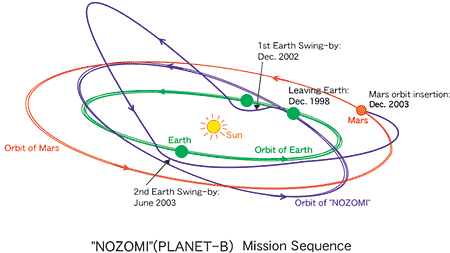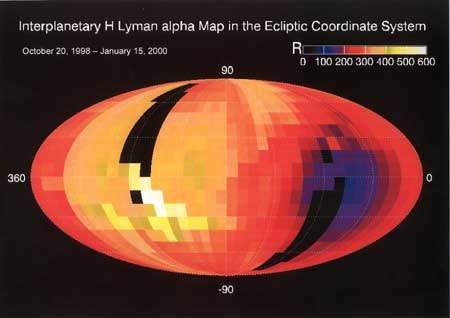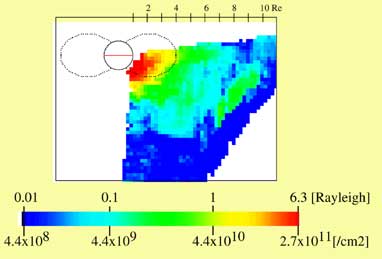TOP > Topics > 2003 > The latest information on the Mars Explorer"NOZOMI"
![]()
The latest information on the Mars Explorer"NOZOMI"
We have received many questions about NOZOMI from subscribers. We answer them below.
Q: What is the future of NOZOMI?
A: If NOZOMI continues along its current trajectory, it will reach the pericenter (the closest point to Mars) on December 14, 2003, and pass by 1,000km over the surface of Mars. If no action is taken hereafter, after passing the pericenter, NOZOMI will enter hyperbolic orbit centering on Mars and then, on December 16, it will escape from the gravitational sphere of Mars and enter orbit around the Sun. After that, it will continue its journey going around the Sun semi-permanently.
Q: Some news media reported that NOZOMI would collide with Mars. Is this true?
A: It is not true. NOZOMI was initially flying along the trajectory that would bring it within 894km of Mars. Since explorer trajectory determination includes a margin of error, we cannot preclude a probability of 1% that NOZOMI would collide with Mars. When we abandoned insertion to Mars’ orbit, we changed the trajectory and increasing the closest distance to Mars to 1,000km in order to reduce the probability of collision. Considering our past experience with orbital control operations, we believe that there is almost no chance of a collision with Mars.
Q: Why shouldn’t NOZOMI collide with Mars?
A: It is possible that life exists on Mars and we, humankind, are trying to explore that possibility. To prevent any adverse effect on life exploration, the Committee of Space Research (COSPAR), an international organization of researchers engaged in space science, announced the policy “The probability Mars orbiters without special countermeasures falling to Mars should be less than 1% within twenty years after launch” (COSPAR planetary protection policy). We, as researchers, have a moral obligation to observe the policy as far as possible. So, if scientific observation becomes impossible, we should make our final efforts to further lessen “the probability of 1%.” Therefore, we are trying to change the trajectory and to keep NOZOMI as far away from Mars as possible.
Q: I heard that NOZOMI experienced some trouble soon after its launch…
A: After launch by M-V rocket on July 1998, NOZOMI orbited the earth for a while. It then performed a swing-by twice to change its trajectory using the Moon’s gravity, and then performed an earth swing-by in end 1998. The swing-by is a technique that greatly alters an explorer’s velocity and direction using gravity and kinetic energy of celestial bodies. Since the swing-by hardly uses any fuel, it enables energy-saving navigation and is an essential technique for planetary exploration.
The earth swing-by on December 20, 1998, to finally escape from the earth’s gravitational sphere, was a “power swing-by,” i.e., NOZOMI was not only passing near the earth but also firing its control engine. At the time, we faced a malfunction in the part of the system supplying oxidizer to the main control engine. The malfunction prevented the precisely calculated acceleration at the scheduled time, and accordingly, the engine was re-fired in an attempt to “send NOZOMI to Mars by all means.” It was later discovered that the control engine had consumed too much fuel, however, and it became clear that we could not put NOZOMI into the planned trajectory toward Mars, even if we were to fire the control engine in October 1999 when NOZOMI was expected to enter the trajectory oriented to Mars.
Q: How did you overcome the first problem?
A: The mission analysis group at ISAS (Institute of Space and Astronautical Science) began struggling with the problem during Christmas 1998. In interplanetary exploration, the enemy is an object moving at extremely high speed. It is very difficult to change trajectory on the way. The issue was whether we could solve the problem by changing trajectory to make up for the fuel shortage.
Generally speaking, once in orbit, a satellite has a life full of ups and downs. There has probably never been a satellite in the world that worked without any trouble during its natural life. Without doubt, when a problem occurs, the most important factor is its ”fatality.” If the problem is within human knowledge and capability, however, the strength of the satellite team leader and the untiring dedication of the talented team members become critical. For even with a satellite or explorer that performed smoothly and achieved excellent results, if you were to ask the project staff about its history, they would probably provide many exciting tales of how they bravely overcame many terrible crises.
NOZOMI’s most critical moment occurred at the end of 1998, when ISAS’s mission analysis group started its desperate struggle to “discover a new trajectory.” They worked right through the Christmas and New Year holidays over 1998 to 1999. At the dawn of 1999, they at last discovered the new trajectory they had been searching for. If we keep the current orbit around the Sun and, then, make an earth swing-by twice to change the trajectory, we could put NOZOMI into the planned orbit around Mars in end 2003. The victory was won with intense effort day and night, making full use of brains and computers.
The NOZOMI group decided that they would change the trajectory and delay the arrival date to Mars from October 1999 to December 2003. Problems still remained, however. NOZOMI had already been in interplanetary space and was in orbit around the Sun. It would circle around the Sun for a long time - four years. Would NOZOMI come out unharmed? The satellite system group made a stern assessment. We were convinced that, “barring an accident, NOZOMI’s systems would operate.” NOZOMI entered a far longer journey than expected. .
|
Q: During the standby period, did NOZOMI simply orbit the Sun without any activity?
A: It is unproductive for NOZOMI to simply fly. We therefore planned important observations for NOZOMI in solar-system space, combined with checks for the onboard instruments.
First, NOZOMI’s Ultraviolet Imaging Spectrometer measured hydrogen Lyman-alpha light in interplanetary space. Lyman-alpha light emitted from the sun is scattered by hydrogen atoms (neutral) floating in interplanetary space and shines in space. It provides an image similar to the beautiful blue sky produced by sunlight scattered by air particles surrounding the earth. Where does the hydrogen come from? The source is the flow of matter in the galaxy called the interstellar wind. The area that appears bright in the distribution map of Lyman-alpha light is, therefore, the flow direction of the interstellar wind. Since hydrogen is light, it is repelled by sunlight pressure, and, thus, it cannot enter inside Jupiter’s orbit in the solar system. Accordingly, the opposite flow direction of the interstellar wind looks dark if we see Lyman-alpha light. NOZOMI observed the intensity distribution of hydrogen Lyman-alpha light in interplanetary space, and measured the direction and volume of the interstellar wind. .
Intensity distribution of hydrogen Lyman-alpha light in interplanetary space |
Electrically charged particles (plasma) always flow out of the earth’s ionosphere. Plasma is bound to the earth by the magnetic field, and does not escape from earth unless there is a large disturbance to the magnetic field. It was thought that cool plasma in the ionosphere is trapped inside magnetic field lines which pass, on average, at an altitude of about four times the earth’s radius over the equatorial plane. Hydrogen ions make up 90% of the trapped plasma and the remainder is mostly helium ions. The helium ions scatter the extreme ultraviolet radiation from the sun. NOZOMI’s extreme ultraviolet telescope caught the scattered light and succeeded, for the first time, in observing the scattered region from the outside. From NOZOMI’s observations, it became clear that more helium ions than predicted flow outward from the region. Some of NOZOM’s observation results are shown above.
Helium ions around earth captured by the extreme ultraviolet telescope |
Q: Why did NOZOMI malfunction in the new trajectory?
A: The event that the system group most feared came to pass: “accidental damage.” It came from 150 million km away. A large flare arose on the sun’s surface in the spring of 2002. NOZOMI was directly hit by a cluster of high-energy particles from the sun causing damage to some of its electrical circuits. Since the overload protection circuits in the common power supply system, which supplied power to the circuit, were activated by the problem, it became impossible to turn on the system from April 26, 2002. As a result, NOZOMI was unable to send telemeter data and its thermal control circuit failed. These conditions have continued to date.
The power supply controls the heater to warm the fuel used for attitude control, and also plays a role in modulating the signal (to make transmission easier) when NOZOMI sends telemeter data on its status and observation results to the ground station. When NOZOMI stabilized itself by spinning, however, it was confirmed that it would not pose a problem to leave NOZOMI as it is for about half a year.
According to our investigation, the power supply system was normal. It was guessed that the circuit short occurred in one of the subsystems. When we sent an ON-command to the system, it turned on for a short period (about 2msec) and then turned itself off - because the power protection breaker for over-current became activated. It is ironic that NOZOMI’s self-protective function has become a problem for us.
Q: Tell us about the passage afterwards.
A: The team, which was in complete deadlock in the spring of 2002, believed that, “NOZOMI will perform an earth swing-by in December 2002. As it approaches earth, its distance from the sun will reduce. The hydrazine should start to melt. We should wait patiently for the fuel to melt.” In order to warm NOZOMI, we turned on the observation instruments in sequence. As a result of detailed thermal analysis, it was forecast that the frozen propellant would unfreeze by itself in September 2002.
The telemeter group launched an intensive effort. On May 15, 2002, we performed an operation to send continuous ON commands to the power for storing the electric charge in the condenser, and to raise the voltage to a certain level. We believed the power supply voltage would rise to a level that would enable the execution of commands. During the operation, we lost the beacon. The cause for this was believed to be turning off the relay in the communication system’s control circuit, which in turn was believed to be a consequence of the random ON/OFF by incomplete power activation. This phenomenon was verified by hardware tests on the ground later.
Conversely, the phenomenon suggested a possibility that the relay could be returned to its original mode by sending an ON command to the power. After sending the power ON command about 7,500 times, the beacon recovered as expected on July 15, 2002. Although time consuming, we also devised an alternative to telemetry, whereby we were able to know NOZOMI’s status only by beacon ON/OFF using its autonomous function. Thus, we were able to monitor the explorer’s housekeeping data.
Another function was installed so that the explorer could perform certain operations by autonomous judgment without any human support. This function is usually unnecessary because we always monitor and control. But, in certain circumstances, the onboard computer reads the value (specified by command from the earth) indicating the explorer’s status, and the explorer executes the command based on this value.
For example, we can set up a command for the explorer to check the temperature of a section, and, if it is higher than the specified value, it turns off the beacon. Narrowing the specified temperature range by inequality sign while confirming the beacon’s ON/OFF, it is possible, though time consuming, to learn the temperature. When the distance to the explorer is far, the work takes a considerable length of time, since confirmation of each inequality sign takes several minutes. The tremendously patient work to check NOZOMI’s health continued step by step, using the feeble communication channel, beacon mode, and NOZOMI’s inherent autonomous functions.
At the end of August 2002, as the distance to the sun was closing, the temperature of the frozen hydrazine (attitude control propellant) gradually rose. At last, we confirmed that it had reached melting point. Attitude and orbital control became possible again, and we successfully changed NOZOMI’s attitude for the first time since the trouble occurred.
From September to December 2002, we performed fine orbital adjustment for the earth swing-by four times and, on December 20, succeeded in conducting a swing-by that had NOZOMI passing 36,000km away from the earth. Then NOZOMI moved away from the ecliptic plane to gain time and then approached earth again slowly. After a precise determination and adjustment of trajectory and attitude change in June 2003, at 11:59:53p.m. on June 19, NOZOMI successfully performed the swing-by, passing 11,000km away from the earth.
From end June to mid July 2003, we carried out attitude change for warming and fine trajectory adjustment after the swing-by. From July to end October, we attempted to correct the malfunction, but unfortunately were not successful.
Q: If NOZOMI does not enter Mars’ orbit, will the money spent on it be wasted?
A: NOZOMI is Japan’s first interplanetary exploration mission. We believe that we can obtain and accumulate many precious experiences for future Japanese planetary explorations including: design expertise for planetary explorers; control technology including swing-by; far-distance communication; operation technology for planetary explorers; and flexible orbital planning and operation. The results were applied fully to the asteroid explorer HAYABUSA launched on May 9, 2003.
In terms of scientific observation, we obtained the results discussed above. Of course, it is our hope that NOZOMI will overcome its present critical situation and join the “Mars rush” of January, 2004, when explorers from the U.S. and Europe will gather near Mars. JAXA is striving to contribute to the accumulation of human wisdom and knowledge by applying the experiences and lessons obtained so far to its future exploration activities. We ask sincerely for your continued support.
December 9, 2003







